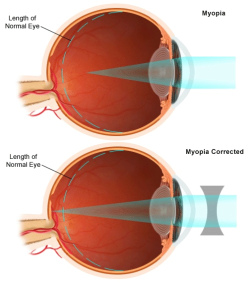What is Myopia?
Myopia or nearsightedness is a refractive error, which points to the need for spectacle prescription. You are nearsighted when you have Myopia. This means you are sighted at near, or you see better at near and worse at far.
Think of the eye as a camera system. The light from an object viewed is focused through the lens system of the eye (i.e., the cornea and crystalline lens) and the image is projected on the film of the eye (the retina, which is in the back of the eye).

The brain takes the information of the retina, interprets the image, and so creates the perception of what we see.
In the case of Nearsightedness, the eyeball is too long and light from an object viewed focuses in front of the retina instead of on the retina. In order to get the light rays to focus on the retina, concave (or minus) lenses are needed.
See depiction:
These concave or minus lenses can be either ophthalmic lenses for glasses or contact lenses, either soft or rigid.
What is extreme Nearsightedness?
In order to view the content, you must install the Adobe Flash Player. Please click
here to get started.
Extreme Nearsightedness typically refers to amounts greater than 6.00 diopters. Extreme Nearsightedness is a source of concern because it can increase the risk for vision-threatening conditions such as:
Retinal breaks and detachment: Since the eyeball is longer than normal in an eye with Myopia, all of the structures inside the eyeball can stretch. As the retina stretches, it can become thinner and be susceptible to develop holes, tears, or to detach altogether.Glaucoma: High Myopia is a risk factor for this disease, which is marked by optic nerve damage and often high eye pressure (ocular hypertension).
Extreme Nearsightedness is often associated with Degenerative Myopia. The degenerative changes in the posterior segment of the eye can result in abnormal visual function, such as a decrease in best corrected visual acuity or changes in visual field.
This means that severe nearsightedness can result in you not being able to see 20/20, even with the correct eyeglass or contact lenses prescription, or in decrease in your side vision.
What else can be done for Nearsightedness?
A large area of study in vision science is that of Myopia control. Several strategies have been developed to slow down the progression of Nearsightedness, especially in children.
Examples include:
Take your glasses off to read. Remember that you can see well at near without glasses. By wearing your glasses to read, you are actually having to use your focusing muscles more, and can thus increase your nearsightedness. However, if your nearsightedness is moderate to high, this may not work. You may have to hold the reading material too close to read, and this is uncomfortable and unrealistic. In the case of moderate to high nearsightedness, you can use magnification lenses at the bottom of your distance eyeglasses in the form of a bifocal. By making letters bigger at near, you don’t have to focus as hard, thus reducing the eyestrain at near and the risk of getting more nearsighted.Studies have been reported showing that rigid contact lenses may slow the progression of nearsightedness in children. Rigid contact lenses have the effect of flattening the cornea. Vision therapy is recommended by some eye doctors. Vision therapy involves eye exercises to improve your focusing ability. Also, these clinicians emphasize good visual hygiene. Good visual hygiene techniques include:
Good lighting when reading at nearTaking rest breaks when doing near work (e.g., looking away from the computer or book every 20-30 minutes and focusing at a distance)Good posture when reading as to reduce muscle stress on the neck and consequently eyestrainMake sure that you get annual eye exams that include a dilated retina examination, especially if you have high Myopia. If you or your child’s Nearsightedness is getting progressively worse each eye exam, ask your doctor about methods of Myopia control to help slow down the progression of this condition.
Return From Myopia to Eye Diseases
Enjoy this page? Please pay it forward. Here's how...
Would you prefer to share this page with others by linking to it?
- Click on the HTML link code below.
- Copy and paste it, adding a note of your own, into your blog, a Web page, forums, a blog comment,
your Facebook account, or anywhere that someone would find this page valuable.





